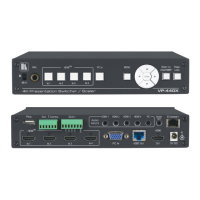Set HDCP mode.
Set HDCP working
mode on the device input:
HDCP supported -
HDCP_ON [default].
HDCP not supported -
HDCP OFF.
HDCP support changes
following detected sink -
MIRROR OUTPUT.
When you define 3 as the
mode, the HDCP status is
defined according to the
connected output in the
following priority: OUT 1,
OUT 2. If the connected
display on OUT 2 supports
HDCP, but OUT 1 does
not, then HDCP is defined
as not supported. If OUT 1
is not connected, then
HDCP is defined by OUT
2.
COMMAND
#HDCP-MODio_mode,io_index, mode<CR>
FEEDBACK
~nn@HDCP-MODio_mode,io_index, mode<CR><LF>
io_mode – Input/Output
0 – Input
1 – Output
io_index – Number that indicates the
specific input or output port.
for input:
1 – HDMI 1
2 – HDMI 2
3 – HDMI 3
4 – HDMI 4
For output: 1
mode – HDCP mode:
for input:
0 – HDCP Off
1 – Auto
For output:
2 – Follow in
3 – Follow out
Set the input HDCP-MODE of
IN 1 to Off:
#HDCP-MOD0,1,0<CR>
Get HDCP mode.
Set HDCP working
mode on the device input:
HDCP supported -
HDCP_ON [default].
HDCP not supported -
HDCP OFF.
HDCP support changes
following detected sink -
MIRROR OUTPUT.
COMMAND
#HDCP-MOD?io_mode,io_index<CR>
FEEDBACK
~nn@HDCP-MODio_mode,io_index, mode<CR><LF>
io_mode – Input/Output
0 – Input
1 – Output
io_index – Number that indicates the
specific input or output port.
for input:
1 – HDMI 1
2 – HDMI 2
3 – HDMI 3
4 – HDMI 4
For output: 1
mode – HDCP mode:
for input:
0 – HDCP Off
1 – Auto
For output:
2 – Follow in
3 – Follow out
Get the input HDCP-MODE of
HDMI 1:
#HDCP-MOD?0,1<CR>
Get command list or help
for specific command.
COMMAND
#HELP<CR>
#HELPcmd_name<CR>
FEEDBACK
1. Multi-line:
~nn@Devicecmd_name,cmd_name<CR><LF>
To get help for command use: HELP (COMMAND_NAME)<CR><LF>
~nn@HELPcmd_name:<CR><LF>
description<CR><LF>
USAGE:usage<CR><LF>
cmd_name – Name of a specific
command
Get the command list:
#HELP<CR>
To get help for
AV-SW-TIMEOUT:
HELPav-sw-timeout<CR>
Set the image size.
Sets the image
properties of the selected
scaler.
COMMAND
#IMAGE-PROPscaler_id,video_mode<CR>
FEEDBACK
~nn@IMAGE-PROPscaler_id,video_mode…<CR><LF>
scaler_id – Scaler number – 1
video_mode – Status
0 – Over scan
1 – Full
2 – Best fit
3 – Pan scan
4 – Letter box
5 – Under 2
6 – Under 1
7 – Follow in
Set the image size to Best fit:
#IMAGE-PROP1,2<CR>
Get the image size.
Gets the image
properties of the selected
scaler.
COMMAND
#IMAGE-PROP?scaler_id<CR>
FEEDBACK
~nn@IMAGE-PROPscaler_id,video_mode<CR><LF>
scaler_id – Scaler number – 1
video_mode – Status
0 – Over scan
1 – Full
2 – Best fit
3 – Pan scan
4 – Letter box
5 – Under 2
6 – Under 1
7 – Follow in
Get the image size:
#IMAGE-PROP?1<CR>
Lock the front panel.
In NT-52N, this
command includes the
PortNumber (1-2)
parameter.
COMMAND
#LOCK-FPlock/unlock<CR>
FEEDBACK
~nn@LOCK-FPlock/unlock<CR><LF>
lock/unlock – On/Off
0 – Off unlocks EDID
1 – On locks EDID
Unlock front panel:
#LOCK-FP0<CR>
Get the front panel lock
state.
In NT-52N, this
command includes the
PortNumber (1-2)
parameter.
COMMAND
#LOCK-FP?<CR>
FEEDBACK
~nn@LOCK-FPlock/unlock<CR><LF>
lock/unlock – On/Off
0 – Off unlocks EDID
1 – On locks EDID
Get the front panel lock state:
#LOCK-FP?<CR>
COMMAND
#LOUDNESSio_index, enabled<CR>
FEEDBACK
~nn@LOUDNESSio_index, enabled<CR><LF>
io_index – 1
enabled – On/Off
0 – Off
1 – On
Set audio loudness:
#LOUDNESS1,1<CR>

